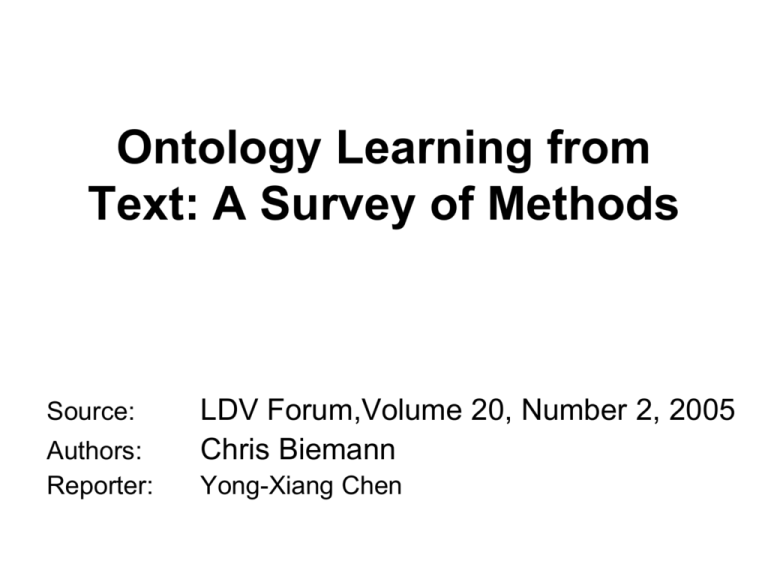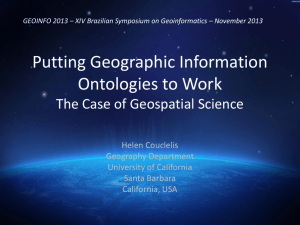Ontology Learning from Text: A Survey of Methods
advertisement

Ontology Learning from Text: A Survey of Methods Source: Authors: Reporter: LDV Forum,Volume 20, Number 2, 2005 Chris Biemann Yong-Xiang Chen The use of ontology • Ontology became a synonym for the solution to that computers do not understand human language – An ontology – Every document were marked up with it – Had agents that would understand the markup • But incredible amount of extra work required for the intellectual encoding of semantic mark-up • Ontology learning has since emerged as an important sub-field of ontology engineering • Ontologies can facilitate text understanding and automatic processing of textual resources • Moving from words to concepts – mitigates data sparseness – promises appealing solutions to polysemy and homonymy by finding non-ambiguous concepts that may map to various realizations • This article gives an overview of different methods that learn ontologies or ontologylike structures from unstructured text Ontologies in Computer Science • Still ontologies in computer science aim at explaining the world(s) • Domain – the world as perceived by an application – Example: The application of a fridge is to keep its interior cold and that is reached by a cooling mechanism which is triggered by a thermostat – not of the food in the fridge – Whenever the application of the fridge is extended, e.g. to illuminate the interior when the door is opened, the fridge ontology has to be changed to meet the new requirements Domain ontologies • Aim at describing a subject domain • Entities and relations of a specific domain are sometimes expressed directly in the texts belonging to it • The more specialized the domain, the less is the influence of word sense ambiguity according to the “one sense per domain”assumption in analogy to the “one sense per discourse”-assumption (Gale et al., 1993) Types of Ontologies • For formal ontologies, the concepts together with is-a relations form the taxonomic backbone of the ontology Formal ontology • Formal ontology is a conceptualization whose categories are distinguished by axioms and definitions • stated in logic that can support complex inferences and computations Prototype-based ontologies • Categories in prototype-based ontologies are distinguished by typical instances or prototypes • Categories are formed by collecting instances extensionally rather than describing the set of all possible instances in an intensional way • Selecting the most typical members for description, and a similarity metric on instance terms has to be defined. Terminological ontology • Partially specified by subtype-supertype relations and describe concepts by concept labels or synonyms rather than prototypical instances, but lack an axiomatic grounding Learning Ontologies from unstructured Text • Most approaches use only nouns as the bricks for ontology building and disregard any ontological relations between other word classes • One underlying assumption for learning semantic properties of words – Harris’ distributional hypothesis (Harris, 1968) – Similar words tend to occur in similar contexts – rise to the calculation of paradigmatic relations (cf. Heyer et al., 2005), called ‘associations’ • Ontology learning techniques can be divided in: – constructing ontologies from scratch – extending existent ontologies Learning semantic properties of words • The notion of context as well as the similarity metrics • The use of patterns that explicitly grasp a certain relation between words – Hearst-patterns (Hearst, 1992) – originally used to extract is-a relations from an encyclopedia for the purpose of extending WordNet • Learning from text usually involves statistics and a corpus – using the world wide web as resource Clustering methods (unsupervised method) • In hierarchical clustering – Sets of terms are organized in a hierarchy that can be transformed directly into a prototype-based ontology – For clustering, a distance measure on terms has to be defined that serves as the criterion for merging terms or clusters of terms – Distance measure also compute the most typical instances of a concept • Crucial to the success of this methodology is – an appropriate measure of semantic distance – a suitable clustering algorithm • Clustering methods for obtaining ontologies from different sources – free text (Maedche and Staab, 2004) • Clustering methods – vector space (Salton et al., 1975) – associative networks (Heyer and Witschel, 2005) – set-theoretic ( Cimiano et al. 2004) • Methods based on distributional similarity Methods using distributional similarity – Syntactic approaches • make use of similarity regarding predicateargument relations • (i.e. verb-subject and verb-object relations) • the usage of adjective modifiers or subjective predicates is rare – Window-based approaches semantic clustering • Hindle (1990) finding semantically similar nouns by comparing their behavior with respect to predicate-argument structures – For each verb-subject and verb-object pair – calculates co-occurrence weights as the mutual information within the pairs – Verb-wise similarity of two nouns is the minimum shared weight – the similarity of two nouns is the sum of all verb-wise similarities obtaining noun hierarchies from text • Pereira et al. (1993) chose an encyclopedia as a well-suited textual resource for a divisive clustering approach based on verb-object relations • allowing the nouns to be members in multiple clusters Classification task (supervised methods) • Given an existing ontology, its extension can be viewed as a classification task • Features of the existing data are used as a training set for Machine Learning – produces a classifier for previously unknown instances utilize the hierarchical structure in a decision tree • When inserting new concepts, it is tested whether they fit best to the actual node or one of the daughter nodes • The tree is traversed top-down from the root until an appropriate position is found • The largest problem here is the general nature of top-level concepts that leads to taking the wrong path in the beginning of the process – For around 1200 concepts, an accuracy of about 28% is reported syntactic dependencies • Witschel (2005), which substitutes the syntactic dependencies for similarity by comparing words only on sentence-based co-occurrences. • A small sub-tree of an existing WordNetlike hierarchy is used as training and test data • The approach is biased towards putting new words into larger sub-trees • Fleischman and Hovy (2002) considered only eight categories for named entities denoting persons • examine five machine learning approaches on features • based on preceding and following word Ngrams which are combined into concepts using WordNet • reporting 70% accuracy Ontology Learning as Semantic Lexicon Construction • Striking the similarities between – the construction of semantic lexicons – lexical ontologies • Both – encode semantic similarities between terms – abstract terms to concepts • Semantic lexicons often attach semantic categories to words and do not structure the set of words internally • Ontologies aim at explaining all possible relations between concepts, being more fine-grained • Assume that we have a small semantic lexicon – given by a set of categories, which are formed each by a set of words. – Using a text corpus, we want to extend this lexicon • Bootstrapping approaches have been used – because bootstrapping can iteratively use previously learnt examples – reduces the minimal size of the seed lexicon – it does not necessarily need negative examples for learning, making the procedure viable for learning single semantic categories • The largest problem that bootstrapping methods have to face is error propagation • Riloff and Shepherd (1997) apply bootstrapping for building semantic lexicons • Their context definition is one noun to the left and one noun to the right for head nouns in sentences • Collecting the contexts of the current category set • calculate a score for each word by checking the relative frequency of the word appearing in the category’s contexts – Amongst the first 100 words retrieved by the algorithm for categories of a seed size around 50, about 25% were judged correct by human decision








